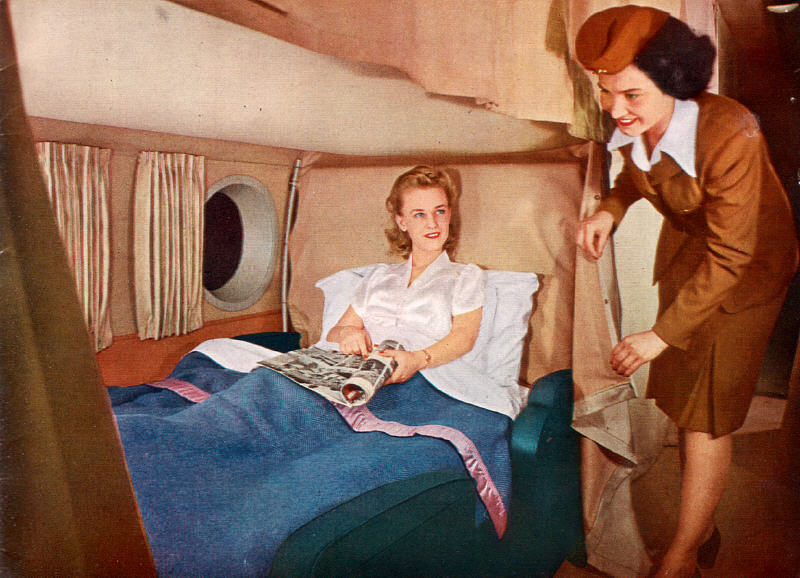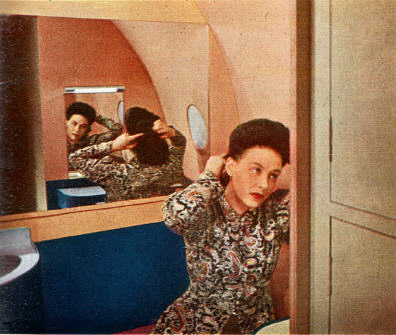










From «Boeing Magazine», September 1945













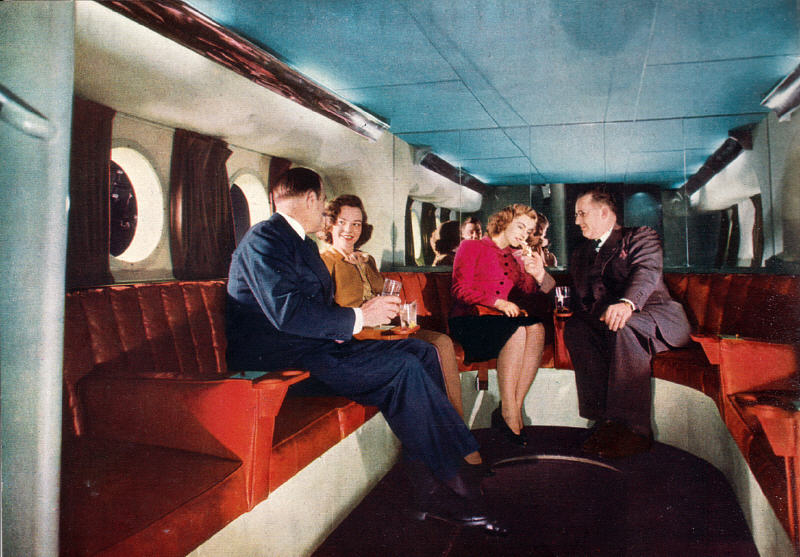
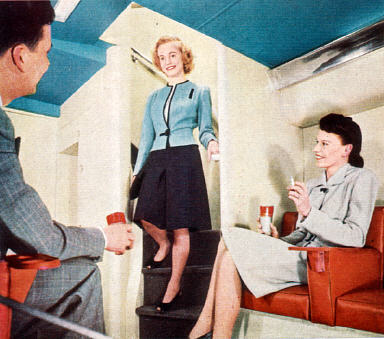
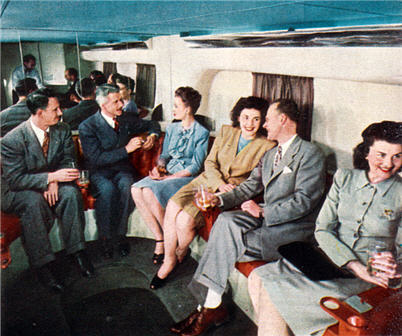
 Do you want to be a passenger on the Boeing Stratocruiser?
Do you want to be a passenger on the Boeing Stratocruiser?THE Boeing Stratocruiser has often been called the airline version of the Superfortress. Yet there is a big difference between the two airplanes. The difference is not in aerodynamic qualities, in performance or in basic design, which in both airplanes is man's best answer so far to the challenge of flight. The difference is that one airplane performs for the exclusive purpose of carrying bombs to a target; the other airplane is devoted to transporting travelers at a speed and in luxury never before offered. The pictures of the interior of the Boeing Stratocruiser, on pages two and nineteen of the Boeing Magazine, show how passengers will travel aboard this airplane in the near future.
Two important things that you can't see in these pictures are air-conditioning and altitude-conditioning. At any high altitude these two elements are of first importance to passengers. Built into the Stratocruiser is the first complete airconditioning unit installed in an airliner. Clean air, warmed to accustomed temperatures or cooled when necessary, and constantly circulating, is injected into the cabin. At altitudes where the outside air is too rarefied for normal breathing without an artificial supply of oxygen, the passenger cabin atmosphere is kept at sea-level or airport-level.
Cabin supercharging equipment keeps the air at sea level density of 14.7 pounds per square inch while the airplane is flying above the country's highest mountain peaks. As the Stratocruiser ascends to 25,000 feet, cabin pressure changes slightly and passengers find themselves at a 6,000-foot pressure—an atmosphere similar to the invigorating air of a mountain resort. Rapid changes in altitude can be made when necessary with little or no change in cabin pressure. Passengers thus avoid ear discomfort due to altitude changes.
Other cabin refinements are designed to keep the passengers as comfortable as if they were in a hotel's most luxurious suite. The larger fuselage allows more than usual space per passenger. The two-deck arrangement, with the lounge on the lower deck, makes a complete change of environment possible. Sound proofing keeps the noise of the engines reduced to a low hum, and vibration is at a minimum. Air sickness and "the elevator sensation" from rough air are at a minimum because of good stability and higher wing loading than customary on older models. Further, the Stratocruiser generally travels at altitudes above most weather disturbances.
The interior arrangement of the Stratocruiser's cabins is flexible. The ships can be equipped to suit the requirements of the airlines flying the plane. The standard version of the long-range Stratocruiser is designed for seventy-five seats. Fifty-six of these then could be made up into berths to accommodate twenty-eight, while sleeper-seats would accommodate nineteen other passengers. With this seating arrangement the lower deck would be devoted to a cocktail lounge. When all available cabin space is used for seats, as many as 114 passengers could be carried.
Roomy upholstered chairs on the top deck are adjustable for reclining and allow plenty of footroom and aisle space. Spacious overhead racks are provided for coats and hand luggage.
The dressing rooms are arranged to give plenty of elbow room, are designed for convenience and are tastefully decorated. The lower deck of the Boeing Stratocruiser contains the cocktail lounge, crew quarters and cargo space.
The Stratocruiser galley is located at the aft end of the main deck. Complete equipment for food preparation and serving is provided. The galley is as compact and convenient as the most modern apartment kitchen.
Along with the Stratocruiser's extraordinary flyability, as reported by passengers and pilots, travelers know that the airplane incorporates all the best qualities of her famous predecessors, the Flying Fortress and the Superfortress.
| The Stratocruiser is planned as a means of travel for all members of American families. Children traveling in this air-minded age will be safe, comfortable and enthusiastic flyers on the Stratocruiser. | The deep, springy club chairs built into the 377 are comfortable for long distance traveling. Passengers can stretch out for a nap with ample room for everyone's feet. |
 | |
The end of the war brings the world to America's doorstep. Airliners will carry travelers to every part of the world. Participating in the traveling will be Boeing people and Boeing planes. Here is the story of the Boeing Stratocruiser and its place in the world of aviation.
The tourist rush is on—right now Americans eager to travel abroad are already making their reservations Steamship lines are sold out for their first tourist sailings. The first civilian peace-time travelers have already taker off. Hundreds of others are getting their bags packed.
Travel by air is naturally uppermost in the minds of most prospective tourists. They are anticipating the materialization of the airlines' post-war prospectus They've heard talk of round-the-world tourist planes; of spending two week vacations in Europe with but overnight travel time; of rates so low that air plane trips will cost no more than ordinary travel before the war.
How are the airlines to meet this flood of post-war commuters and world wide tourists? They're planning on more airliners, larger and faster airplanes, and an over-all increase in facilities. The Boeing Stratocruiser was designed for manufacture to meet this need for an airliner to carry many passengers at high speed and low operating cost for long or short distances. It can be the "Greyhound" of the air or offer the travel luxury of a millionaire's yacht. It is adaptable for every future requirement of a major airline operating in the post-war flight era.
The Model 377 Stratocruiser is the peace-time version of the present Army C-97 which itself was developed from the B-29. The C-97 and the 377 are essentially the same, one built for military cargo and troops, the other for passengers.
What will the airlines need in an airplane for both domestic and international runs? Probably the most important consideration for economical air transportation is the cost of operating the airplane. Second is the airliner's performance; its speed, range and load. Third, it must give passengers comfort, luxury and a feeling of security. Another important consideration for the airlines is that their new airplanes be not a futuristic ship whose qualities are doubtful, but a highly modern airplane with proved characteristics. Further, the airplane must have the highest standards of reliability and safety. Maintenance and servicing should be easily handled.
Let us see how the Boeing Stratocruiser fills these requirements. First, the 377's operating cost is the lowest of any transport now built or designed. The direct cost of flying a Stratocruiser, for instance, will be substantially less than eight-tenths of a cent per passenger mile, over a wide latitude of ranges from 500 to 2000 miles, and less than five cents per ton-mile of cargo.

These figures are the cost of operating the airplane, which includes fuel, depreciation, overhaul, crew and insurance costs. With these direct costs as a basis, the indirect costs are added. Among these are operations, traffic and administrative expenses of the airlines. The actual cost of air passage could cut present rates substantially, or provide additional margin to be put into better services.
The operating cost of the Boeing Stratocruiser is reduced to this new low by a combination of design features that contribute to efficiency. Its efficient Boeing 117 wing, its high wing loading and aerodynamic design produce top performance. Due to this, the amount of load that can be carried for the size of the plane is at a maximum. The high speed of the airplane reduces its travel time and cuts fixed costs per mile.
The Stratocruiser's performance caught the eye of the nation when the C-97, prototype of the 377, made its record breaking flight. Non-stop, the C-97 covered the distance from Seattle to Washington, D. C. in six hours, three minutes, fifty seconds, to break the record held previously by a fighter plane. The C-97's average speed was 383 miles per hour.

The 377 version of the C-97 is expected to give even better performance as it will be equipped with new, more powerful engines and more efficient propellers. The Stratocruiser's cruising speed is 340 miles per hour compared with the current transport cruising speed of 185 miles per hour. The Stratocruiser's most economical range with payload is from 1000 to 2700 miles. For example, it flies, at lowest cost, 2500 miles carrying 19,200 pounds. Present transports carry, as an equivalent, 3,000 pounds 900 miles. In ratio of load carried to total weight propelled through the air, the Stratocruiser transports 43 per cent of its weight as useful load compared to 33 per cent for present transports.

The Stratocruiser is not limited, because of its size, to the role of a longdistance airplane. While its most economical operating range extends up to 2,700 miles, that is not the limit of its flights—it can carry a payload up to 4,200 miles. The Stratocruiser is adaptable to any airplane's range requirements. It is a short range, medium range and long range airplane all incorporated in one. The 377 can easily fill all the demands of passengers and cargo handling required by commercial travel. It is equally efficient for domestic, short distance, high density traffic; or for long range, over-ocean luxury travel.
Flying at ceilings unattainable to the usual transport, the 377 can reach 30,000 feet, but even more important, it can operate at 22,000 feet and higher with one engine out. This altitude is more than sufficient for greatest safety. The Stratocruiser's unexcelled performance is inherent in its design. The 377 has the Boeing 117 airfoil which is considered the most efficient wing yet designed. The low gross weight per horsepower allows the airplane to carry greater loads without an increase in wing area. This new combination also allows a better rate of climb and higher cruising speeds. The Stratocruiser is aerodynamically cleaner than any comparable craft.

Passengers travel in altitude air-conditioned cabins that even at 15,000 feet maintain sea level conditions inside. When operating at this level, rapid ascent and descent' can be made with no change in cabin pressure. At 25,000 feet actual altitude, the cabin altitude is equivalent to 6,000 feet.
Warm, clean air is circulated through the compartments of the Stratocruiser. The temperature may be 45 below zero outside but it's cozy in the cabin. In hot weather at lower altitudes, the air conditioning unit keeps it cool. At the Stratocruiser's high altitudes above storms and weather disturbances, "rough air" is at a minimum. Even when rough air is encountered at lower altitudes, the plane's high wing loading aids in smoothing out air bumps. The insulated cabin reduces flying noise to a minimum.
These many features of the 377 have been tested and proven. The Boeing Stratocruiser is not a "paper airplane." The "bugs" have been eliminated through extensive tests of the prototype, and the design has the benefit of the hundreds of thousands of hours of B-29 and B-17 combat experience. The test of war on every element of these airplanes has brought great refinements. Both have become famous for their ability to take it and to come home even when damaged so badly it seemed impossible the airplane would fly. Into the 377 has been inculcated a11 the experience of Boeing's four-engine years, dating from 1935 and including not only the Forts and the Superforts but the B-15 bomber, the Stratoliners and Pan American Clippers.

The Stratocruiser possesses even greater safety and reliability than is presently accepted as standard. It operates with greater safety because of the pilot's excellent visibility, good stall warning and good stall characteristics, excellent stability, unusual ease of control and because of the high-lift flap and exceptional ruggedness of the dual wheel tricycle landing gear. War-developed electronic devices will be available for installation to overcome low-ceiling hazards.
The Stratocruiser can be easily controlled under all conditions including the loss of one or two engines. The Stratocruiser's internal systems are designed for simplicity of operation and maintenance. Other systems such as landing gear retraction and flap operation are all electric. Icing hazards are eliminated by a system which provides a flow of heat to wing and empennage surfaces, preventing ice from forming.

Ground service, maintenance and inspection of the Boeing Stratocruiser are highly simplified. The two-lobe construction makes possible easy access to all plumbing, electrical and control assemblies, which are grouped for greatest convenience.
Power plants are quickly removable and are accessible without removal for inspection, adjustment or minor repair. All four units have been made interchangeable in order to simplify overhaul and engine change procedures.
Design for maintenance was a part of the original conception of the airplane. As a result, the maintenance of many items has been minimized or eliminated.
These many advantages of the Boeing Stratocruiser will make possible the air travel Americans have been dreaming of.
Just as the Boeing Stratoliner and before that the revolutionary Boeing 247, both pace-setting airplanes in their day, were adopted by the airlines to speed their service and increase their growth, so the Stratocruiser will spur ahead the age of air transportation.


 ONE of the biggest jobs shop 27, the mockup boys at Plant 1, have ever tackled was the 377 mockup. This mockup of the Boeing Stratocruiser is settled right in the middle of the mockup shop and is as fascinating as a world's fair exhibit. It is a demonstration of the interior of tomorrow's airliner. While a mockup is a sample of a design, it is no makeshift construction. The interior of the Stratocruiser is a realistic duplicate of the projected real thing.
ONE of the biggest jobs shop 27, the mockup boys at Plant 1, have ever tackled was the 377 mockup. This mockup of the Boeing Stratocruiser is settled right in the middle of the mockup shop and is as fascinating as a world's fair exhibit. It is a demonstration of the interior of tomorrow's airliner. While a mockup is a sample of a design, it is no makeshift construction. The interior of the Stratocruiser is a realistic duplicate of the projected real thing.

To build it, the men of shop 27 were called on for all sorts of hidden talents. Two ex-upholsterers found themselves with needles doing much of the sewing required in the furnishings of the cabin. Rug-laying, leather work, lighting, were all part of the mockup job. They turned out cocktail glasses, lacquered food trays, hundreds of mechanical gadgets. They built berths, installed upholstered chairs, got together all the furnishings used in the interior of the huge airliner.
The pictures in this magazine were taken by Stewart Love in the Seattle Plant 1 mockup. Modeling as passengers were a host of Boeing employees who donated their time after work for the movies and still photos taken of the Stratocruiser. A movie man for Paramount covered the event and a short feature on the Stratocruiser will be released. Film for use by the company was also taken.
Shooting the pictures required some ingenuity on the part of the photographers. In the cocktail lounge scene, for instance, the camera faced a large mirror that reflected everything in the room including the camera, cameraman and lights. To get themselves out of the picture these three foreign objects had to be strategically hidden behind the cocktailers.
The photographers were particularly anxious to have a lot of color in the color shots. So a group of eight girls, who were to be models, were assigned eight different bright colors to wear. Even the men were encouraged to appear in their loudest suits. Stan Bakke, eager to cooperate, arrived at the "studio" one evening carrying over his arm a wardrobe of three suits, for scene changes.
When the "rushes" of the movies were shown in Hollywood, the professionals were impressed by the excellent acting of Boeing "extras." Best character actor, in the opinion of Bill Sandiford, Boeing assistant advertising manager who directed the pictures, was Myron Russell. "In the photographs," remarked Sandiford, "Russ looked just like a human being."

"Stewardess" Dorothy Bennett "had a relaxed face and always a natural expression." Tim McCarthy, bartender and cook, was the "heavy." He had a beard that always wanted to be in the picture. Tim shaved his blue-black stubble before every shot, but under the lights his camera-happy whiskers always peeped out.
Several children were used for models and turned in a very natural performance. One little girl got tired during the shooting, so she was put to bed in a Stratocruiser berth while the evening's work went on.
Most of the models found their job hard work. The batteries of lights were hot and the fan had to be turned off when camera work began. The fan vibration jolted the camera. So did footsteps. Guards were posted throughout the ship, when the camera was working, to keep everyone quiet and off their feet.
During all the shooting under the steaming, hot, high-powered lights, there were two silent characters who were never in the pictures. They were a pair of firemen who sat at the edge of each scene with their fire extinguishers trained on the actors.
SUPPOSE you were starting a vacation tomorrow—by air. Or suppose you were going to allow yourself a sabbatical leave and spend a couple months at the job of touring the world. Where do you want to go?
Just get a pencil to follow these air routes on the map and to figure the times. Now, is it Australia you're anxious to visit? Or Moscow? China? Paris?
The schedules on this map are calculated by Stratocruiser speed. A weekend in London becomes an actual possibility on this basis. By the same token, it won't take you long to get to South America or to go around the world on the Stratocruiser. Your travels that were flights of fancy during war-time years can be flights of reality now.
